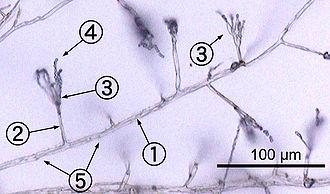Submitted by Aspergillus Administrator on 2 June 2014
 |
| Bioreactor facility |
Aspergillus species and other fungus are intensively used in industry for the production of chemicals useful in food e.g. citric acid, gluconic acid and commercially important enzymes eg glucosamylase, pactinase. To do this the fungus is incubated in large growth containers (bioreactors) into which food is regularly added – and due to the ubiquitous appetites of fungi that food can be waste from other food industries eg mussel processing watewater! This can make the use of fungi very efficient in terms of cost and natural resources.
There is constant work carried out to make this process more efficient and less costly as of course profits can be maximised and product costs cut.
 |
| Long threads of filamentous fungus |
One problem with the use of filamentous fungi in bioreactors is that the long threadlike structure of Aspergillus tends to encourage clogging and tends to wrap itself around the impellers used to ensure growth medium is circulated sufficiently. This demands the use of more expensive reactor designs.
Individual threads also tend to break in rapidly circulating media, killing some threads and thus reducing yield.
In order to alleviate these problems it would be helpful if we could change the fungus to grow as much shorter threads. Research has shown that the long threads are encouraged by genes responsible for polarized growth. In its natural environment these genes would be used to direct growth towards food without wasting energy going off in other directions! In a bioreactor these genes are not needed as the fungus is always surrounded by food.
This recent paper shows us the results of switching off the polarizing genes in Aspergillus when using it in a bioreactor. The fungus now grows as small pellets rather than long threads and remarkably production of the commercial enzyme has increased by over 80%. It isn’t difficult to see the importance of this discovery – cheaper products, less waste, cheaper to manufacture.
News archives
-
Title
Date


